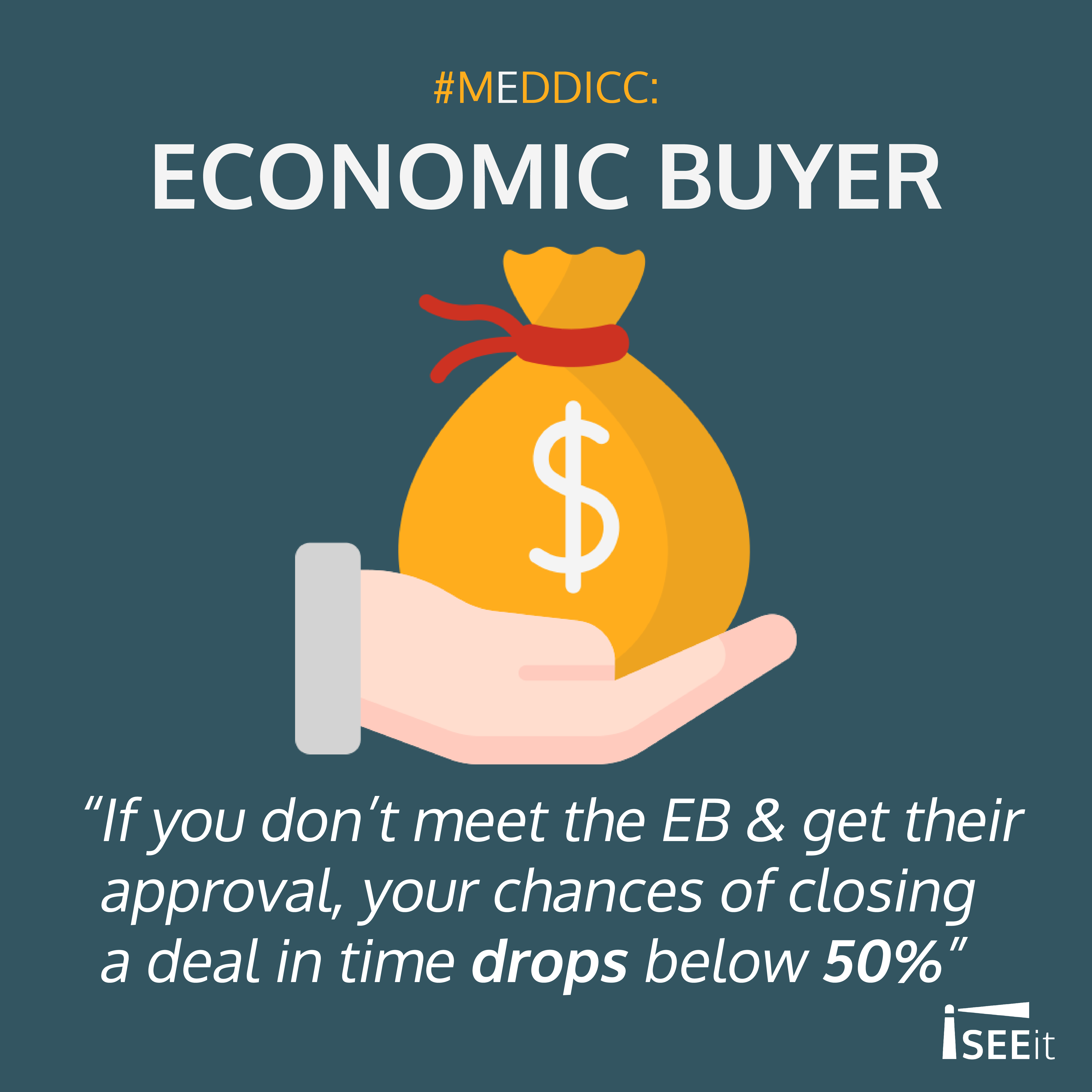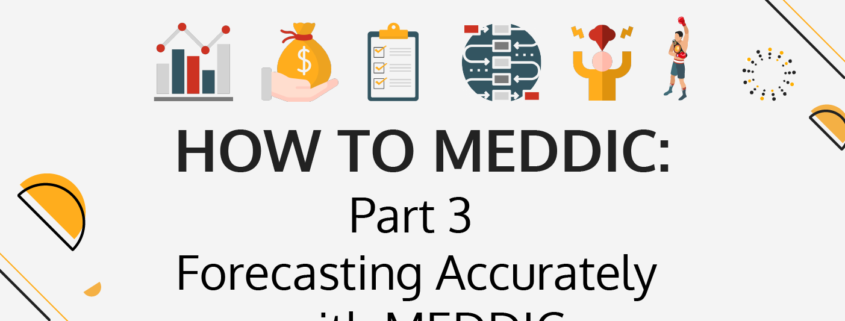How to MEDDIC: Part 3 – Forecasting Accurately with the MEDDIC Sales Methodology
In Part 1 and Part 2 of our How to MEDDIC series, we shared how you can use the MEDDIC sales methodology to qualify your sales pipeline and conduct deal reviews to drive those deals to closure. In Part 3 of this series, we’ll discuss how MEDDIC can help you drive an accurate forecast.
Did you know that the main driver behind the development of MEDDIC was centered on wanting to create a more accurate forecast? In the 90s, when the growth at PTC started to slow down, the the sales teams there together with Dick Dunkel and Jack Napoli began analyzing thousands of deals that closed, slipped and stalled. This analysis ultimately led to the creation of the MEDDIC Sales Methodology.
They found out that while the deals might’ve progressed based on some activities, they eventually fell apart in the final weeks of the quarter. As they dug deeper, they discovered that when a deal was lost, it was due to one of the qualifiers in MEDDIC not being complete. The most common factors that lead to a lost deal were:
- Not having a real Champion
- No access to the Economic Buyer
- Uncompelling or no quantification of Pain and ROI
- Getting beat out by Competition
- Lacking time to close the deal before the quarter ended
So, how does MEDDIC help us drive an accurate forecast? What actually makes a forecastable deal? No matter if you’re a sales rep or a sales manager, the foundation of an accurate forecast lies in the answers to the 5 major questions that qualify our deals in the forecast.
- Is there a compelling reason for the client to act?
- Do we have a strong Champion?
- How is our access to the business?
- Can we control and influence the next steps?
- Do we have answers to the 3 WHYs?
1. A Compelling Reason for the Client to Act
Your client must have a compelling reason to purchase your solution, and this compelling reason is usually a pain point (The “I” in MEDDIC). As we’ve discussed in Part 1, the pain point needs to be strong. Here are some questions you can ask your client to qualify the pain point:
- How big is the pain?
- Does somebody own the pain?
- How high is this person in the chain of command?
- Does solving the problem impact the business?
- Can you quantify the pain in hard metrics that will stand the test with the CFO?
Would my solution be a nice-to-have or would it play a pivotal role in alleviating your pain point? (If it turns out to be a nice-to-have, the close rate drops to as low as 15%)
2. Developing a Strong Champion

Developing a strong Champion takes time. It certainly takes more than a quarter. Your potential Champions want to solve their pain points for personal reasons (career progression, reputation, monetary, optimizing processes, etc..). They will want to understand if and how you and your solution could support them.
Make sure you can nurture them by educating, supporting and connecting them to people who can solve their pain point. Once they believe you are capable of driving the solution with or for them, they will support you, get you connected, give you great insights ahead of time and defend your joined project when things go awry – which they always do.
So, if you don’t know your Champion’s personal interest, power and influence, you probably haven’t nurtured the person enough to ask for next steps and more insights. In this case, you will probably not be able to influence or drive the opportunity. When this happens, the deal is considered very risky and should not go into the forecast.
3. Access to the Business
Once you’ve identified and nurtured your Champion, you need to stick close to them to get as much intel as possible in order to find out when compelling events are happening. Compelling events such as quarter ends, budget allocation period, yearly kick-offs, and investment rounds will drive your prospect’s urgency to act and are great anchors to plan potential close dates. In fact, these compelling events often crank up decision making by 80+%.
After identifying the compelling events, you now need to convince the multiple stakeholders involved in the decision making process why they should choose you. Oftentimes, you’d need to have the answers to these questions
- What makes your offering so compelling?
- Can the client confirm this?
- Who are you competing against?
- Is this competition external or internal (eg. do nothing or DIY)
4. Controlling Next Steps – Did you meet the Economic Buyer?

The Economic Buyer or the board of decision makers have the discretionary power to make decisions. They have this ability to drive your deals through expediting internal processes, draw attention to the importance of the project and allocate the right people. Hence, it is crucial that these people understand how their success criteria can be met. Ideally, you should meet the Economic Buyer 6-8 weeks before your planned close date. Anytime the Economic Buyer supports the project and timeline, the close rates crank up to more than 80%.
5. Prepare the Answers to the 3 Whys
When it comes to complex deals, there will be many stakeholders involved in the decision making process. There is a high probability that you might not get to meet most of them. Hence, great salespeople document the answers to the 3 whys onto 3 slides that the champion can use for internal meetings:
- Why do anything?
- Why is your solution the best fit?
- Why buy now? (the compelling reason to act)
In this way, the most important facts can be presented in a crisp manner, which can be quickly discussed during meetings in a clear and consistent way.
Creating a Close Plan with your Client
Great salespeople have a master plan on how to close their deals on time. They are aware of the resources, timing and cornerstones of their client’s buying & paper process.
They always prepare for the worst, are to address issues and have a plan B to turn things around if needed. Preparing a mutual close plan allows you to understand and control the accomplishments of the sales campaign and collaborate with your clients on working towards the close plan, ensuring that all parties are aligned.

Conclusion
Driving a forecast with MEDDIC removes many unconfirmed assumptions, enabling you to drive a consistent, fact-based discussion around what we know and what we don’t know about the customer’s buying process. It allows you to promptly take corrective action together with your Champion if things don’t go according to plan.
Remember, the CFO or any board approving the finances will almost always ask these 3 questions:
- Why do we have to do anything here?
- This is where MEDDIC/MEDD(P)ICC will come in handy in fueling the answers regarding pain, the implication to the business, collecting quantifiable metrics of success and creating a tangible reason to act
- Why should we pick this vendor?
- Over here, you want to be sure you present your unique selling points so that you can stand out from the competition, understand their strengths and weaknesses, so that you can shape your prospect’s Decision Criteria in your favor.
- What happens if we don’t decide to execute the project now?
- This is what makes it compelling for the board to prioritize this project over the others. Here’s where you should present the compelling event of the pain and the strongest metrics around the consequences of not acting now. Ideally, you’d want to create a timeframe or a close plan so that you and your client can work towards it together.
Statistics have shown that teams forecasting this way consistently stay within +10%/-10% of their forecast. Plus, they often experience a much smoother closing as they stay in control until the deal is closed.
Hear more from Steve Reid, Founder & CEO of Venatas, as he shares more on how MEDDIC has enabled him to help his clients achieve a forecast accuracy of 90%







Leave a Reply
Want to join the discussion?Feel free to contribute!